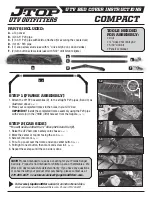
Driver assistance systems
Factors that may affect how the radar sensor
operates
If laser sensor operation is impaired, due to
heavy rain, spray, snow or mud, the ACC is
deactivated temporarily. The relevant text
message will appear in the dash panel dis-
play. If necessary, clean the radar sensor.
When the radar sensor begins to operate
properly again, the ACC will automatically be
available again. The message on the instru-
ment panel screen will switch off and the ACC
will be reactivated again.
ACC operation may be affected by a strong ra-
dar reverse reflection, for example in a closed
car park.
Trailer towing
When driving with trailer the ACC controls
less dynamically.
Overheated brakes
If the brakes overheat, for example after
abrupt braking or in long and steep slopes,
the ACC may be deactivated temporarily. The
relevant text message will appear in the dash
panel display. In this case, adaptive cruise
control cannot be activated.
Adaptive cruise control can be reactivated
once brake temperature has cooled suffi-
ciently. The message will disappear from the
instrument panel display. If the message
ACC
not available
remains on for quite a long time
it means that there is a fault. Contact a speci-
alised workshop. SEAT recommends visiting
a SEAT dealership.
WARNING
If the message ACC ready to start appears on
the instrument panel display and the vehicle
in front starts up, the vehicle will start up au-
tomatically. In this case the radar sensor may
not detect obstacles on the road. This could
cause an accident and serious injuries.
●
Before driving off, check that the road is
clear. If necessary, apply the brake.
Monitoring system Front
Assist*
Introduction
The Front Assist Monitoring system helps to
prevent rear collisions.
The Front Assist can warn the driver of colli-
sion hazards, prepare the vehicle for emer-
gency braking in case of danger, assist the
driver on braking and cause automatic brak-
ing.
The Front Assist is not a replacement for
driver awareness.
Distance warning
If the system detects that safety is endan-
gered by the proximity of the vehicle in front,
it may warn the driver by means of a message
on the instrument panel when driving at a
speed of between approximately 60 km/h
(37 mph) and 210 km/h (130 mph)
.
The warning moment varies depending on
the traffic situation and driver behaviour.
Pre-warning
If the system detects a possible collision with
the vehicle in front, it may warn the driver by
means of an audible warning and an indica-
tion on the instrument panel when driving at
a speed of between approximately 30 km/h
(18 mph) and 210 km/h (130 mph)
.
The warning moment varies depending on
the traffic situation and driver behaviour. At
the same time, the vehicle will prepare for a
possible emergency braking
Critical warning
If the driver fails to react to the pre-warning,
the system may actively intervene in the
brakes when driving at a speed of between
approximately 30 km/h (18 mph) and
210 km/h (130 mph), generating a brief jolt
to warn of the imminent collision.
»
161
Tec
hnic
al s
pec
ific
ation
s
Adv
ic
e
Oper
ation
Saf
ety
The e
ssenti
al
s
Summary of Contents for 2014 LEON CUP RACER
Page 1: ...OWNER S MANUAL Leon 5F0012720BC Inglés 5F0012720BC 11 14 GT9 Leon Inglés 11 14 ...
Page 4: ......
Page 8: ...The essentials Fig 2 6 ...
Page 10: ...The essentials Fig 4 Right hand drive 8 ...
Page 65: ......
Page 66: ...Operation Fig 81 Instruments and controls 64 ...
Page 281: ......
Page 282: ......
Page 284: ...OWNER S MANUAL Leon 5F0012720BC Inglés 5F0012720BC 11 14 GT9 Leon Inglés 11 14 ...
















































